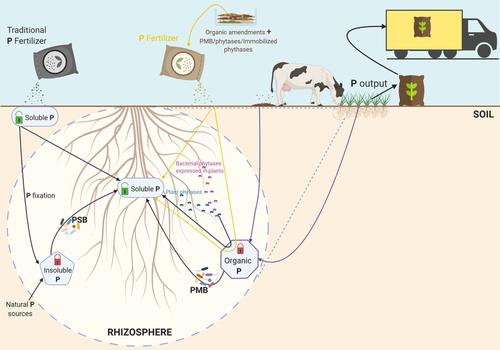当前位置:
X-MOL 学术
›
Ann. Appl. Biol.
›
论文详情
Our official English website, www.x-mol.net, welcomes your feedback! (Note: you will need to create a separate account there.)
Phosphobacteria as key actors to overcome phosphorus deficiency in plants
Annals of Applied Biology ( IF 2.6 ) Pub Date : 2021-01-05 , DOI: 10.1111/aab.12673 Luis N Castagno 1 , Analía I Sannazzaro 2 , María E Gonzalez 1 , Fernando Luis Pieckenstain 1 , María J Estrella 2
Annals of Applied Biology ( IF 2.6 ) Pub Date : 2021-01-05 , DOI: 10.1111/aab.12673 Luis N Castagno 1 , Analía I Sannazzaro 2 , María E Gonzalez 1 , Fernando Luis Pieckenstain 1 , María J Estrella 2
Affiliation

|
Phosphorus (P), an essential macronutrient for all living organisms, is required in large amounts for the growth and development of plants. Although total soil P level is high, P bioavailability to plants is suboptimal in most soils because of high fixation rates into inorganic and organic insoluble complexes. Hence, plants are highly dependent on mechanisms that allow them to adapt to low‐phosphate stress and/or achieve suitable levels of soluble P on the root surface. In this regard, the rhizospheric microbiota plays a key role in facilitating P nutrition and has long been recognised for their potential use as an environmental‐friendly alternative to chemical P fertilisation. Herein, we outline the advances in the identification of phosphate solubilising bacteria and phosphate mineralising bacteria, collectively known as phosphobacteria, and their role in rendering P accessible to plants. We review and discuss research progress related to the introduction of phosphobacteria and/or P‐mineralising enzymes into soil, as well as plant transformation with bacterial genes that encode such enzymes, as strategies to improve plant growth and P nutrition. We also provide an overview of studies about the impact of variations in soil P levels on the structure of soil and rhizospheric microbial communities and the potential consequences of such perturbations on plant growth. Finally, we discuss possible directions for future research to optimise the efficiency of biofertilisation strategies based on the use of phosphobacteria.
中文翻译:

磷细菌是克服植物缺磷的关键因素
磷(P)是所有活生物体必不可少的大量营养素,是植物生长和发育所需的大量磷。尽管土壤中的总磷水平很高,但由于对无机和有机不溶性复合物的固定率很高,因此在大多数土壤中植物对磷的生物利用度都不理想。因此,植物高度依赖于使其适应低磷酸盐胁迫和/或在根部表面达到合适水平的可溶性P的机制。在这方面,根际微生物区系在促进磷素营养方面发挥着关键作用,并因其潜在的用途而成为公认的化学磷素肥料的环保替代品。在此,我们概述了磷酸盐溶解细菌和磷酸盐矿化细菌(统称为磷细菌)的鉴定进展,以及它们在使植物可利用P方面所起的作用。我们回顾并讨论与将磷细菌和/或P矿化酶引入土壤以及用编码此类酶的细菌基因进行植物转化(作为改善植物生长和磷营养的策略)有关的研究进展。我们还提供了有关土壤磷水平变化对土壤和根际微生物群落结构的影响以及这种扰动对植物生长的潜在影响的研究综述。最后,我们讨论了未来研究的可能方向,以基于磷细菌的使用来优化生物受精策略的效率。我们回顾并讨论与将磷细菌和/或P矿化酶引入土壤以及用编码此类酶的细菌基因进行植物转化(作为改善植物生长和磷营养的策略)有关的研究进展。我们还提供了有关土壤磷水平变化对土壤和根际微生物群落结构的影响以及这种扰动对植物生长的潜在影响的研究综述。最后,我们讨论了未来研究的可能方向,以基于磷细菌的使用来优化生物受精策略的效率。我们回顾并讨论与将磷细菌和/或P矿化酶引入土壤以及用编码此类酶的细菌基因进行植物转化(作为改善植物生长和磷营养的策略)有关的研究进展。我们还提供了有关土壤磷水平变化对土壤和根际微生物群落结构的影响以及这种扰动对植物生长的潜在影响的研究综述。最后,我们讨论了未来研究的可能方向,以基于磷细菌的使用来优化生物受精策略的效率。我们还提供了有关土壤磷水平变化对土壤和根际微生物群落结构的影响以及这种扰动对植物生长的潜在影响的研究综述。最后,我们讨论了未来研究的可能方向,以基于磷细菌的使用来优化生物受精策略的效率。我们还提供了有关土壤磷水平变化对土壤和根际微生物群落结构的影响以及这种扰动对植物生长的潜在影响的研究综述。最后,我们讨论了未来研究的可能方向,以基于磷细菌的使用来优化生物受精策略的效率。
更新日期:2021-01-05
中文翻译:

磷细菌是克服植物缺磷的关键因素
磷(P)是所有活生物体必不可少的大量营养素,是植物生长和发育所需的大量磷。尽管土壤中的总磷水平很高,但由于对无机和有机不溶性复合物的固定率很高,因此在大多数土壤中植物对磷的生物利用度都不理想。因此,植物高度依赖于使其适应低磷酸盐胁迫和/或在根部表面达到合适水平的可溶性P的机制。在这方面,根际微生物区系在促进磷素营养方面发挥着关键作用,并因其潜在的用途而成为公认的化学磷素肥料的环保替代品。在此,我们概述了磷酸盐溶解细菌和磷酸盐矿化细菌(统称为磷细菌)的鉴定进展,以及它们在使植物可利用P方面所起的作用。我们回顾并讨论与将磷细菌和/或P矿化酶引入土壤以及用编码此类酶的细菌基因进行植物转化(作为改善植物生长和磷营养的策略)有关的研究进展。我们还提供了有关土壤磷水平变化对土壤和根际微生物群落结构的影响以及这种扰动对植物生长的潜在影响的研究综述。最后,我们讨论了未来研究的可能方向,以基于磷细菌的使用来优化生物受精策略的效率。我们回顾并讨论与将磷细菌和/或P矿化酶引入土壤以及用编码此类酶的细菌基因进行植物转化(作为改善植物生长和磷营养的策略)有关的研究进展。我们还提供了有关土壤磷水平变化对土壤和根际微生物群落结构的影响以及这种扰动对植物生长的潜在影响的研究综述。最后,我们讨论了未来研究的可能方向,以基于磷细菌的使用来优化生物受精策略的效率。我们回顾并讨论与将磷细菌和/或P矿化酶引入土壤以及用编码此类酶的细菌基因进行植物转化(作为改善植物生长和磷营养的策略)有关的研究进展。我们还提供了有关土壤磷水平变化对土壤和根际微生物群落结构的影响以及这种扰动对植物生长的潜在影响的研究综述。最后,我们讨论了未来研究的可能方向,以基于磷细菌的使用来优化生物受精策略的效率。我们还提供了有关土壤磷水平变化对土壤和根际微生物群落结构的影响以及这种扰动对植物生长的潜在影响的研究综述。最后,我们讨论了未来研究的可能方向,以基于磷细菌的使用来优化生物受精策略的效率。我们还提供了有关土壤磷水平变化对土壤和根际微生物群落结构的影响以及这种扰动对植物生长的潜在影响的研究综述。最后,我们讨论了未来研究的可能方向,以基于磷细菌的使用来优化生物受精策略的效率。



























 京公网安备 11010802027423号
京公网安备 11010802027423号